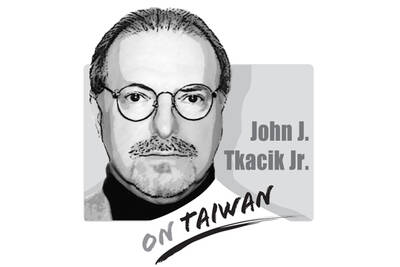For a long time, the air force’s battle plan has been to use segments of the nation’s freeways as contingency runways for its military aircraft in the event of an invasion and the Chinese People’s Liberation Army’s (PLA) destroy or damage the nation’s runways.
Currently, the distribution of Taiwan’s runways is mainly concentrated in the western part of the country — including the freeway sections in Changhua County’s Huatan (花壇), Chiayi County’s Minsyong (民雄), Tainan’s Madou (麻豆) and Rende (仁德), and Pingtung County’s Jiadong (佳冬). The first four are all on freeways, while the Jiadong section is on Provincial Highway 1.
However, in recent years, the PLA Navy and Air Force have increased their range and capabilities with the addition of fighters that can fly longer distances, and the commissioning of air refueling tankers and aircraft carriers. As a result, the frequency of various types of PLA aircraft flying around southeastern and eastern Taiwan has increased.
In the past, Hualien County’s Jiashan (佳山) airbase and Taitung County’s Chihang (志航) airbase in eastern Taiwan were regarded as the air force’s final resort from which to counterattack, because of their underground caves and underpass networks.
Today, the security of the Jiashan and Chihang airbases is threatened by the frequent PLA flights near Taiwan. A practical policy response to meet these threats is for the air force to establish an additional runway in eastern Taiwan, so as to diversify the risk fighters would face in taking off and landing there.
From the perspective of national security and air defense, I support the air force building an additional runway in eastern Taiwan. Perhaps those against it would argue that Taiwan is already within the range of PLA rockets and cruise missiles, would another runway not also be subject to the PLA’s firepower?
This argument is not entirely wrong. However, from the perspective of defense, the more new runways and arms storage the nation builds, the more it would increase the PLA’s cost of attacking Taiwan. In other words, from the perspective of the defense, in order to disperse the PLA’s ballistic missile attacks, it is necessary for the air force to build an additional runway in eastern Taiwan.
As for the highly urbanized western part of Taiwan, there is almost no room to add another runway. Since the eastern part of Taiwan is less developed than the western part, and the former is relatively sparsely populated, the addition of a runway in eastern Taiwan is not only a necessity, but also a much better option for the “Taiwan-Pescadores defense operation.”
Residents of eastern Taiwan, rather than opposing the construction of an additional runway, should consider how a new runway in the region would help the air force’s fighter jets evacuate to stay in the fight, which would strengthen the nation’s defense.
Ray Song is a doctoral student at Tamkang University’s Graduate Institute of International Affairs and Strategic Studies.
Translated by Eddy Chang

“Si ambulat loquitur tetrissitatque sicut anas, anas est” is, in customary international law, the three-part test of anatine ambulation, articulation and tetrissitation. And it is essential to Taiwan’s existence. Apocryphally, it can be traced as far back as Suetonius (蘇埃托尼烏斯) in late first-century Rome. Alas, Suetonius was only talking about ducks (anas). But this self-evident principle was codified as a four-part test at the Montevideo Convention in 1934, to which the United States is a party. Article One: “The state as a person of international law should possess the following qualifications: a) a permanent population; b) a defined territory; c) government;
The central bank and the US Department of the Treasury on Friday issued a joint statement that both sides agreed to avoid currency manipulation and the use of exchange rates to gain a competitive advantage, and would only intervene in foreign-exchange markets to combat excess volatility and disorderly movements. The central bank also agreed to disclose its foreign-exchange intervention amounts quarterly rather than every six months, starting from next month. It emphasized that the joint statement is unrelated to tariff negotiations between Taipei and Washington, and that the US never requested the appreciation of the New Taiwan dollar during the
Since leaving office last year, former president Tsai Ing-wen (蔡英文) has been journeying across continents. Her ability to connect with international audiences and foster goodwill toward her country continues to enhance understanding of Taiwan. It is possible because she can now walk through doors in Europe that are closed to President William Lai (賴清德). Tsai last week gave a speech at the Berlin Freedom Conference, where, standing in front of civil society leaders, human rights advocates and political and business figures, she highlighted Taiwan’s indispensable global role and shared its experience as a model for democratic resilience against cognitive warfare and
The diplomatic spat between China and Japan over comments Japanese Prime Minister Sanae Takaichi made on Nov. 7 continues to worsen. Beijing is angry about Takaichi’s remarks that military force used against Taiwan by the Chinese People’s Liberation Army (PLA) could constitute a “survival-threatening situation” necessitating the involvement of the Japanese Self-Defense Forces. Rather than trying to reduce tensions, Beijing is looking to leverage the situation to its advantage in action and rhetoric. On Saturday last week, four armed China Coast Guard vessels sailed around the Japanese-controlled Diaoyutai Islands (釣魚台), known to Japan as the Senkakus. On Friday, in what